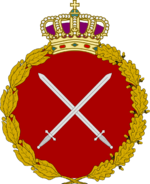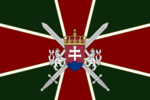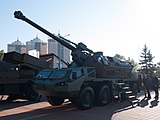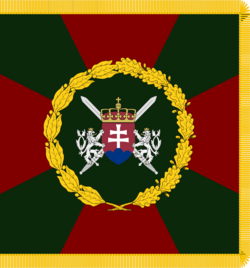Holyn Ground Forces
| Holyn Ground Forces | |
|---|---|
| Holynské Pozemné Sily | |
Emblem of the Holyn Ground Forces | |
| Active | 1923–present |
| Country | |
| Type | Army |
| Size | 190,000 active duty 370,500 reserve |
| Part of | Royal Holyn Defence Forces |
| Headquarters | Cizekporok |
| Colors | Red Black Grey Green |
| Anniversaries | 3 March |
| Engagements | Bogorian War for Independence Holyn-Bogorian Border Conflict (2002-present) |
| Commanders | |
| Commander of the Holyn Ground Forces | |
| Deputy Commander of the Holyn Ground Forces | |
| Insignia | |
| Flag | |
| Holyn Kingdom Defence Forces |
|---|
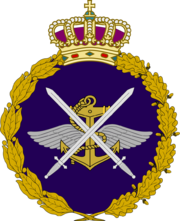 |
| Command |
| Staff |
| Services |
| Geographic Commands |
|
| Specialist Commands |
|
| History of the Holyn military |
The Holyn Ground Forces (Holyn: Holynské Pozemné Sily) is the land forces of the Royal Holyn Defence Forces. As of 2020, the Holyn Ground Forces has 190,000 active duty and 370,500 reserve personnel, totalling 580,500 personnel. It maintains forces across Holynia in both active duty and part time reserve roles.
History
The Narodna Rada dissolved the Armed Forces of the Union of Holyně Socialist States on 20 May 2000. The Defence Forces of the Holyn Republic were formed on the same day. The Ground Forces, the new land warfare branch, inherited the personnel, command structure and equipment of the former communist Holyn Army. The military was in a rapid state of collapse with desertions, low morale, destroyed equipment, and limited funding. With the conclusion of the Bogorian War and drastic changes in the geopolitical landscape, a massive demobilization had to be undertaken. The Ministry of Defence wrote off entire divisions that were deemed unneccesary. The Ground Forces went from 20 divisions in 2000 to 9 by 2001.
Unification with Skoskie
Adding to the challenges to reform the military, a national referendum on reunification with the former Holyn colony of Skoskie was held on 10 September 2000. The referendum saw overwhelming support for reunification. Skoskie, which by 2000 was an independent nation with its own military and defence industry, was to become an overseas territory of Holynia.
The Holyn and Skoskie governments agreed that Skoskie's armed forces, the Royal Skoskie Defence Force, would merge with the mainland military. Military representatives from Holynia and Skoskie formed the Military Unification Group to develop the best course of action for reunification. The Skoskie military consisted of roughly 92,500 active soldiers. It was decided in June 2001 that the remoteness of Skoskie and relatively low threat to the territory, that the structure RSDF could not be retained. Skoskie's military would form the core of Holyn Forces Skoskie, a smaller contigent of the Holyn military stationed in Skoskie. This force would number at roughly 12,000 active soldiers. A division sized contigent would form the Ground Force contribution to Holyn Forces Skoskie.
The remaining RSDF commissioned officers, non-commissioned officers and career soldiers were offered discharge or relocation to the mainland. Roughly 51,000 personnel of the RSDF opted to relocate to mainland Holynia, with another 9,000 remaining with Holyn Force Skoskie. Personnel who opted to relocate retained their rank and service history. The pay rate of the RSDF could not be maintained as the mainland military was five times larger than the RSDF. The reduction in pay for former members of the RSDF would depend on many factors. All other personnel were honorably discharged from service.
Very little equipment of the RSDF was retained. The Skoskie military was much smaller and was built for a different purpose than the Holyn military. The most notable equipment retained post unification was the infantry combat uniform and work uniform of the RSDF, which proved popular with mainland soldiers.
Post-war reforms
Mainland Holynia's military was viewed as "inefficient" by the new government. Minister of Defence Cvesek stated a top to bottom reform had to occur. A post-war parliamentary commission also recommended the Ground Forces be rebuilt. The commission found a bloated officer corps and lack of NCOs led to poor control of the ground forces when dealing with the quasi insurgency in Bogoria. Contradictory orders led to failed operations and high casualties. Poor training, especially of infantry contributed to the high casaulty rate. Lack of coordination and communication with the Air Force meant air support, the biggest advantage the Holyn military had, was insufficient.
A seperate parliamentary inquiry accused the ground forces of participating in an "organized ethnic cleansing campaign" organized by "senior officers". Roughly 7,000 enlisted and commissioned personnel were dishonorably discharged related to these events. Public opinion gradually turned against the military as details of wartime attrocities were publicised.
In March 2003, the first reform plan was unveiled before the Narodna Rada. The Ground Forces would be reduced to a total personnel count of 400,000 active duty. Among other reforms proposed were ending conscription and reducing the number of commissioned officers.
2003 Reform Proposal
- Reduce Ground Forces from 750,000 active personnel to 400,000.
- Create a professional NCO corps.
- Reduce officer count.
- End conscription by 2005.
- Increase size of reserves.
- Increase personnel pay.
The reforms began to implemented in the fall of 2003, with a series of buyouts of commissioned officers and merging several military academys. In January 2004, the new reserve structure was unveiled, with a officer corps and enlisted corps. The Defense Ministry set a goal of having 2 reserve divisions fully staffed with officers and enlisted personnel by 2005. In May 2004, the first mainland NCO academy was established in Cizekporok at the former campus of the defunct Military-Political Academy. Many of the instructors were former Skoskie military NCO school instructors.
Significant reorganization of the structure of the Ground Forces continued throughout 2005. The Military Districts were dissolved, with the command structure changing from (Military District - Army - Division - Regiment) to (Unified Military Command - Division - Regiment). The Unified Military Commands would be unified commands for all branches of the Defence Forces, with the goal of creating better coordination between branches.
In February 2005, the final draft was held with 13,000 men conscripted into the Ground Forces for 12 month mandatory service. The new contract/volunteer program for enlisted personnel began with the 785th Recruitment Brigade established. Four more recruitment brigades would be founded in 2005 to assist with attracting and retaining contract personnel. The Ministry of Defence stated 40% of conscripts in 2005 opted to remain in the military, signing 4 year contracts. Higher pay was attributed to the rise in contract personnel, with pay rising from U$300/month for a conscript to U$1,900/month for a entry level contract soldier.
Significant rivalries and disputes existed in the military. Officers who served in the former Skoskie military were viewed as elitist by mainland officers. These rivalries died down by the 2010s as the number of active former RSDF officers gradually decreased.
2009 rearmament plan
In 2009, Defence Minister Boris Přibyl announced a proposal to re-equip the armed forces by 2020. Weapons procurement had halved in the 2000s compared to the 1990s levels. Annual defence spending allocated to procurement reached a low point in 2004, as budgets were geared towards the organizational shakeup of the military. The Ground Forces had a major need for new equipment, with roughly 30% of combat equipment lost during the war in Bogoria. The reforms had resulted in the Ground Forces maintaining an air corps, specifically helicopter units.
The proposal was approved by the Narodna Rada in 2010, with a 50% increase in defence funding. The 2010 election saw a change in government, however, the re-equipment program was retained and arms deals began to be signed in early 2011. The program saw new main battle tanks, armored vehicles and surface to air missiles enter service with the ground forces by 2013. Older weapon systems were also upgraded during this period, bringing much of the armed forces up to modern standards. In 2015, the rearmament plan became embroiled in a corruption scandal involving the Ratkovic government. Members of the government were accused of accepting bribes from defence companies. In return, these companies were favored in contracts. This led to the eventual downfall of the Ratkovic government. Arms sales dropped in the 2016 budget as parliament investigated the claims. Several senior officers were forced to resign, including the commander of the ground forces.
Structure
The Ground Forces are commanded by the Ground Forces Commander, a General of the Army, from the Ground Forces Headquartes in the Defence Ministry building in Cizekporok. Three operation commands, Ground Force Operations Command, Ground Force Training and Support Command, and Special Operations Command are subordinate to the Ground Forces Command. The Capital Defence Command reports directly to the Ground Forces Headquarters and is independent of the other Ground Forces Command. Five geographic commands, roughly equivalent of a corps are subordinated to the Ground Force Operations Command. The five geographic commands consist of 2-3 motor rifle (combined arms) or tank (armoured) divisions.
Personnel branches
Personnel in the Holyn Ground Forces belong to a Personnel Branch applicable to their trade/unit. These include the Motorised Rifle (Infantry), Tank (Armoured), Artillery, Rocket Artillery, Air Defence Corps, Aviation Corps, among others. Several sub-branches gain additional distinction. These include (in order of precedence): Life-Guards, Royal Guards and standard Guards units.
Life Guards troops are the personal division of the Holyn monarch. The Life Guards are the formal personal protection detail of the monarch. Formally they report directly to the King, but de-facto follow the standard chain of command of the Ground Forces. They are considered the most elite branch of the Ground Forces and wear special uniforms as the personal protection detail of the monarch. They perform ceremonial guard duties throughout the capital.
Hussars troops are the calvary branch of the Ground Forces. They are the quick reaction forces of the Ground Forces and tend to be equipped with Main Battle Tanks and light vehicles, combining both speed and armour in their ranks. They wear seperate uniforms from standard Motor Rifle troops. They are considered elite units, above a standard Guards unit.
Motor Rifle troops are the infantry branch of the Ground Forces. They are equipped with a variety of weapons for different tasks including armored troop carriers, tanks, artillery, anti-aircraft weapons and mortars. The Ground Forces have 7 Motor Rifle divisions.
Tank troops are the armored branch of the ground forces. Tank divisions are made up primarily by Tank regiments. Main battle tanks are the primary equipment of the tank troops, however other heavy weaponry including fire support vehicles support main battle tanks. Tank troops are geared as shock forces, meant to break through enemy lines and lead offensive operations. The Ground Forces has 5 Tank divisions.
Artillery and Rocket Artillery troops make up artillery regiments. They are geared to support motor rifle troops and tank troops by providing fire support.
Intelligence, Signals, Reconnaisance and Communications troops are one of the support branches of the Ground Forces. The Aviation Corps consists of enlisted and officers responsible for flying and maintaining the aircraft of the Ground Forces. The Air Defence Corps is responsible for the air defence of the Ground Forces as well as maintaining a wide array of fixed radars across Holynia. The Royal Medical Corps is responsible for healthcare services of the Ground Forces and frequently assists the other branches of the Defence Forces. The Logistics Corps assists with supplies and maintanance of the ground forces.
Personnel
The personnel of the Ground Forces consist of 201,600 active duty and 370,500 reserve personnel. Regular Service personnel are active duty enlisted personnel. They are full-time professional soldiers who sign a four year initial contract and additional contracts between four to nine years. Primary Reserves consist mainly of combat and support units. The other aspect of reserve personnel are the Secondary Reserve, which primarily consist of support units. Both Reserves are paid and receive benefits, but at a lower scale compared to Regular Service personnel.
Conscription was the primary form of recruitment prior to 2005. All personnel since 2005, full-time and reserve, have been volunteers. Enlisted personnel that were originally conscripted prior to 2005 still remain in the ground forces. They make up 9% of active duty personnel and have voluntarily signed contracts since being enlisted.
Regular Service
The Regular Service personnel are 190,600 active duty full-time enlisted and commissioned personnel. They are subject to deployment and have long term contracts. Training is subsidised for enlisted personnel, while officer cadets pay tuition which is then waived once they receive their commission. Regular Service personnel receive pay based on rank and length of service. They make up 52 regiments, 21 seperate battalions and 11 seperate companies. Many regiments are only enlisted from specific demographics or regions. Regular Service personnel make up the entirety of the household division (9th Guards Tank Household Division Cizekporok - Prince Vinazlec). All other divisions divide regiments into Regular Service and Primary/Secondary Reserve.
All enlisted and officer cadet recruits receive 5 weeks of initial training, either Initial Soldier Training or Initial Cadet Training. Enlisted personnel then move onto specialised training of 9-12 weeks for their respective trade. Officer cadets will move onto their respective academy.
Many Regular Service personnel sign contracts which commit them to 2-5 years of Primary/Secondary Reserve service. All other enlisted Regular Service personnel who elect to leave either are discharged or become Immediate Reserve, which is seperate from the Primary/Seconday Reserve. Immediate Reserve is a holdover from the Communist era. Immediate Reserve receive no pay and no obligation for training. In an emergency, Parliament may call up Immediate Reserve for active duty. In the Communist era, this duty was mandatory for all military personnel leaving on good terms, however since 2002 has been voluntary.
Primary Reserve
The Primary Service consists of 210,500 personnel. They are part-time and full-time volunteer soldiers, NCOs and reserve officers. Primary Reserve are both civilian volunteers and Regular Service personnel who volunteered for Primary Reserve. Primary Reserve undergo similar initial training to Regular Service personnel and receive ongoing training which they must attend at least 2 days per month. Some Primary Reserve units are at constant readiness, meaning some members, generally officers, work full time. Primary Reserve personnel are assigned to units, similar to Regular Service units, but are only part time manned units. The Primary Reserve staffs all front line reserve units along with support units. Most Divisions feature a 40/60 mix of Regular Service and Reserve personnel. Primary Reserve may be called up for service by the Minister of Defence for up to 365 days.
Secondary Reserve
Secondary Reserve consists of 160,000 part time personnel. Secondary Reserve undergos similar training to the Primary Reserve. Secondary Reserve staff most support divisions and several administrative units. They do not serve in front-line units, receive less pay than Regular Service or Primary Reserve personnel. They must attend drills 2 days per month and may be activated for up to 365 days by the Minister of Defence. Secondary Reserve heavily recruits medical, clerical and other skilled trades to man specific units.
Organization
The Holyn Ground Forces has been re-structured from its communist-era division-centric force into a flexible network-based brigade-centric force. Motor rifle and tank divisions still form the core formations of the army. However, manueaver forces now are centered on the brigade sized forces called Brigade Combat Force (Brigádne bojové sily), which are capable of sustaining operations, with its own supply and support units. Each is a stand-alone combined arms force of mechanised infantry, tanks and artillery, with combat support and sustainment elements in significantly higher proportions than old-style motor rifle and tank regiments. A motor rifle brigade has three motor rifle battalions (one mounted in tracked-IFVs, the other two in wheeled-APCs) and one tank battalion, whereas the ratio is reversed in tank brigades (all infantry in tank brigades are tracked). A motor rifle brigade possesses some 4,500 troops and forty tanks, whereas a tank brigade has some 4,000 personnel and more than 90 tanks (a tank battalion attached to a motor rifle brigade has one extra company of ten vehicles).
The HGF Aviation Corps inherited the majority of the helicopter fleet from the Air Force in 2005. Typically a Division has an Aviation Regiment attached to it. The Aviation Regiment provides combat, reconassiance and transport helicopters to the Division.
| Type of unit | Field Army (Wartime) | Commands (Peacetime) | Division | Brigade Combat Force | Regiment | Company, Squadron, Battery | Platoon or Troop | Section | Fire team |
|---|---|---|---|---|---|---|---|---|---|
| Contains | 3 divisions | 2 divisions | 6-9 regiments, 9-10 support battalions, 2-3 support companies | 3–5 regiments | 4–6 companies | 3 platoons | 3 sections | 2 fire teams | 4 individuals |
| Personnel | 37,000 | 25,000 | 12,000 | 5,000 | 700–1,000 | 120 | 30 | 8–10 | 4 |
| Commanded by | Armádní generál | Armádní generál | Generálporučík | Podplukovník | Podplukovník | Major | Nadporučík or Poručík | Rotný | Četař |
Equipment
Equipment summary
| Type | Active | Reserve |
|---|---|---|
| Main battle tanks | 1,627 | 2,338 |
| Infantry fighting vehicles | 2,457 | ≈2,600 |
| Armoured personnel carriers | 2,435 | ≈1,800 |
| Towed artillery | 3,071 | ≈8,000 |
| Self-propelled artillery | 3,071 | ≈1,800 |
| Rocket artillery | 1,352 | 900 |
| AA systems | 1,137 | ≈900 |
Uniforms
The uniforms of the Ground Forces vary between service branches and units. The standard officer daily service uniform is a pine green jacket with green epaulettes. A peaked cap is worn with a gold cockade of the Ground Forces emblem. The daily service uniform features green plastic/fabric buttons. The formal service uniform adds gold/red piping to the uniform, a red band on the cap and gold buttons to the coat. Gold epaulettes replace the green epaulettes. The enlisted service uniform is the same, with red epaulettes replacing the gold on the formal service uniform. The winter model adds a green great coat for both junior officers and enlisted. A parka is also offered. This may be worn with or without the jacket depending on needs of the soldier. A brown belt may also be worn depending on the occasion.
The standard parade uniform is split into the inspection model and the stand by model. The inspection model is for soldiers walking out on parade. Officer models feature a gold ceremonial belt with commission sword signifying their status as an officer. Enlisted and non-commissioned officers (NCOs) wear a white belt. Jack boots are worn with the walk out model of the parade uniform. The great coat for senior officers is grey instead of the standard gold.
The work uniform consists of either a camoflauge or pine green shirt with epaulettes. Berets replace the peaked caps. Boots are typically worn, either sage green or black (depends on the unit).
The combat uniform consists of a HolCam 2 camoflauge pattern coat, with accompying gear. Sage green boots are the only authorized combat boots.
Specific units wear different parade uniforms than standard servicemembers. The officer and enlisted uniform of the Royal Hussars is a red tunic with a closed collar. Hussars wear a shako instead of a peaked cap. The Royal Life Guards wear a red tunic with closed collar, but retain the standard peaked cap. The Royal Dragoons wear a light black/grey closed collar tunic with a shako. All these specific units wear a grey great coat in the winter. They retain the standard service uniforms of the Ground Forces for all other uses.
Ranks and insignia
Officers
| NATO code | OF-10 | OF-9 | OF-8 | OF-7 | OF-6 | OF-5 | OF-4 | OF-3 | OF-2 | OF-1 | OF(D) | Student officer | ||||||||||||||||||||||||
|---|---|---|---|---|---|---|---|---|---|---|---|---|---|---|---|---|---|---|---|---|---|---|---|---|---|---|---|---|---|---|---|---|---|---|---|---|
Epaulette rank insignia (Parade variant) |

|

|

|

|

|

|

|

|

|

|

|

|
No equivalent | |||||||||||||||||||||||
| Marshal Maršal |
Army General Armádní generál |
Colonel General Generál plukovník |
Lieutenant General Generál Poručík |
Major General Generál Major |
Colonel Plukovník |
Lieutenant Colonel Podplukovník |
Major Major |
Captain Kapitán |
First Lieutenant Nadporučík |
Second Lieutenant Poručík |
Officer Cadet Kadet | |||||||||||||||||||||||||
Epaulette rank insignia (Service variant) |

|

|

|

|

|

|

|

|

|

|

|

|
No equivalent | |||||||||||||||||||||||
| Marshal | Army General |
Colonel General |
Lieutenant General |
Major General |
Colonel | Lieutenant Colonel |
Major | Captain | First Lieutenant |
Second Lieutenant |
Officer Cadet | |||||||||||||||||||||||||
Other ranks
| NATO code | OR-9 | OR-8 | OR-7 | OR-6 | OR-5 | OR-4 | OR-3 | OR-2 | OR-1 | ||||||||||||||||
|---|---|---|---|---|---|---|---|---|---|---|---|---|---|---|---|---|---|---|---|---|---|---|---|---|---|
Epaulette rank insignia (Parade variant) |

|

|

|

|

|

|

|

|

|

| |||||||||||||||
| Chief Warrant Officer Štábní praporčík |
Senior Warrant Officer Nadpraporčík |
Warrant officer Praporčík |
Master Sergeant Nadrotmistr |
Sergeant First Class Rotmistr |
Staff Sergeant Rotný |
Sergeant Četař |
Corporal Desátník |
Private First Class Svobodník |
Private Vojín | ||||||||||||||||
Commanders
Commander-in-chief (2001–present)
- Borek Šimek (2002)
- Emanuel Dvořák (2002-2003) Acting
- Leoš Navrátil (2003-2005)
- Medard Adamec (2005-2007)
- Kazimír Král (2007-2011)
- Herman Krejčí (2011-2015)
- Jan Vlček (2015) Acting
- Hugo Poláček (2015) Acting
- Svatopluk Jeřábek (2015-2016)
- Alexandr Šrámek (2016-2019)
- Valentín Chrobák (2019-present)
